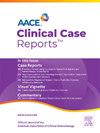Ovarian Hyperthecosis Presenting as Polycythemia
IF 1.2
Q3 Medicine
引用次数: 0
Abstract
Background/Objective
A 58-year-old postmenopausal woman presented with polycythemia on routine laboratory examinations along with long-standing hirsutism. The objective of this report is to highlight polycythemia as a rare presenting feature of ovarian hyperthecosis (OH).
Case Report
A 58-year-old woman presented with elevated hemoglobin and hematocrit levels in the primary care setting on routine laboratory examinations. On further workup, she was found to have elevated testosterone levels. Further history was relevant for excessive facial hair, frontal hair loss, and deepened voice. Examination findings were consistent with significant hirsutism. Adrenal and ovarian imaging was negative for tumor. The patient elected to have laparoscopic bilateral oophorectomy, which revealed OH on surgical pathology. After 2 months of surgery, the total testosterone levels became normal, and polycythemia resolved.
Discussion
In a postmenopausal woman, hirsutism with virilization should generally prompt urgent investigation because these signs are associated with malignant androgen-secreting tumors of the adrenal gland and ovaries. However, these symptoms can also be the result of benign causes such as OH.
Conclusion
This case is a rare illustration of OH in a postmenopausal woman presenting with polycythemia secondary to severe hyperandrogenism. Suspicion for this condition is crucial in evaluation for rare causes of polycythemia because if left untreated, it can lead to increased morbidity and mortality.
卵巢过度增生表现为红细胞增多症
背景/目的一名58岁绝经后妇女在常规实验室检查中表现为红细胞增多症,并伴有长期多毛症。本报告的目的是强调红细胞增多症是卵巢囊肿(OH)的一个罕见的表现特征。病例报告一名58岁女性,在初级保健机构的常规实验室检查中出现血红蛋白和红细胞压积水平升高。在进一步的检查中,发现她的睾丸激素水平升高。进一步的病史与面部毛发过多、额部脱发和声音低沉有关。检查结果与明显的多毛症一致。肾上腺及卵巢影像学未见肿瘤。患者选择腹腔镜双侧卵巢切除术,手术病理显示OH。术后2个月,总睾酮水平恢复正常,红细胞增多症消退。绝经后的女性,多毛伴男性化通常需要紧急检查,因为这些症状与肾上腺和卵巢的恶性雄激素分泌肿瘤有关。然而,这些症状也可能是良性原因的结果,如OH。结论:本病例是一例罕见的绝经后妇女因严重的高雄激素症并发红细胞增多症而患OH的病例。对这种情况的怀疑对于评估罕见的红细胞增多症病因至关重要,因为如果不及时治疗,它可能导致发病率和死亡率增加。
本文章由计算机程序翻译,如有差异,请以英文原文为准。
求助全文
约1分钟内获得全文
求助全文
来源期刊

AACE Clinical Case Reports
Medicine-Endocrinology, Diabetes and Metabolism
CiteScore
2.30
自引率
0.00%
发文量
61
审稿时长
55 days
 求助内容:
求助内容: 应助结果提醒方式:
应助结果提醒方式:


